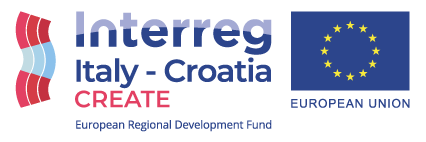There are urban areas along roads designed and built in such a way that they filter rainwater and allow it to be absorbed by the ground, rather being discharged into the sewage system. As a result, when it rains, especially when it rains a lot, the urban landscape is prepared to handle the water below ground level, minimising the damage to people, housing and economic activities.
And then, there are coastal areas built to defend the city from rising sea levels while maintaining the functionality and architectural qualities of the urban fabric.
You don't have to go far to find these solutions and see them working concretely, they are sometimes right before our eyes, on the Adriatic coasts of Italy and Croatia, and these are the realities that the CREATE project has brought together - "Climate REsponses for the AdriaTic rEgion" with a clear objective to show the success stories of solutions identified and implemented to respond to climate change, to collect best practices, experiences, testimonies, to make them available to all local administrations, businesses, citizens so that they can draw inspiration and motivation to produce their solutions to adapt to climate change.
And so the Adriatic Adaptation Award was given to the city of Pula, Istria, for the way it designed and implemented its rain gardens, or natural infiltration systems, which, through the use of natural structures such as gardens and ditches, protect against flooding in the event of heavy rainfall. An example to explain more concretely what this is all about is King Tomislav Square. If only a few years ago this hub of city life was a car park prone to flooding with every heavy rainfall, today the square has completely changed its face. The spaces are organised on different levels to accommodate meeting points for people and areas for strolling. The whole thing is then designed in such a way that, in the event of rain, significant quantities of water are partially retained at the lowest point of the square before flowing into underground basins and finally being gradually discharged underground and, in part, into the sewage system, so as not to overload it.
But there is not only Pula. The Create project's commission of experts analysed many projects and then nominated four of them. Among them was the city of Rimini and its Sea Park. Here, after a careful analysis of the impacts linked to climate change, it was decided to raise the seafront by 80 cm compared to the past to remedy a series of problems linked to rising sea levels. At the same time, this initiative is part of the much more complex project, which also takes into account the impacts of heat waves and rainfall and is therefore designed in such a way as to provide areas of shade and with materials that mitigate heat in hot weather. The whole project is based on an drainage system which collects rainwater and gradually discharges it into the sewage system rather than flooding the streets, pavements and finally polluting the sea.
Other projects that received mentions from CREATE were the Emilia Romagna region and its Strategy of the Integrated Management for Protection and Adaptation of the Coast to climate change (GIDAC), and the Ethnological Park "Anton Plašimuha" at the Municipality of Lovran in Istria.
“CREATE has analyzed what had already been produced by previous projects financed by the Interreg programme Italy Croatia and selected the most useful experiences, tools and practices to support local adaptation in the area”, explains Margaretha Breil, CMCC scientist and coordinator of the project. “Once a project is finished – Breil concludes – many of the often-useful products remain on the shelves, as nobody has funding to continue working on them. CREATE's goal is to continue to bring these results to life and make them available to society.”
“Another added value of CREATE for climate change adaptation lies in the successful practices of coastal planning identified in Emilia Romagna and in Split-Dalmatia County” say Daria Povh Sugor from Pap/Rac. “These coastal plans are founded in the Protocol on Integrated Coastal Zone Management in Mediterranean – only regional legal document for the coasts in the world. Two coastal plans are demonstrating a wiser approach to the more resilient and sustainable future of our coasts. Coastal zones are among the most endangered regions by the impacts of the climate change, Mediterranean coasts in particular. These two examples, as well as other identified good practices in two countries by CREATE will be promoted by PAP/RAC along all Mediterranean coasts, since PAP/RAC is the UNEP Mediterranean centre for coastal management.”
The results of the CREATE project were presented on June 14 in Venice, during the Final Conference of the project at NH Rio Novo Hotel.
CREATE - "Climate REsponses for the AdriaTic rEgion" is a Project funded within the framework of the Italy-Croatia Cross-border Programme under Axis 2 - Safety and Resilience, coordinated by CMCC, Euro-Mediterranean Centre on Climate Change Foundation, with the participation of Italian and Croatian partners such as Energy Institute Hrvoje Pozar, IUAV - University Institute of Architecture of Venice, CNR, Abruzzo Region, PAP-RAC, IOF - Croatian National Institute for Oceanography and Fisheries, Split-Dalmatia Region.
CREATE jointly analyses and synthesises the results obtained in all relevant projects of the axis and provides systematic access to this knowledge to improve the transferability of project results with conferences, workshops and webinars with partners and stakeholders and initiatives to show good examples of implementation.
